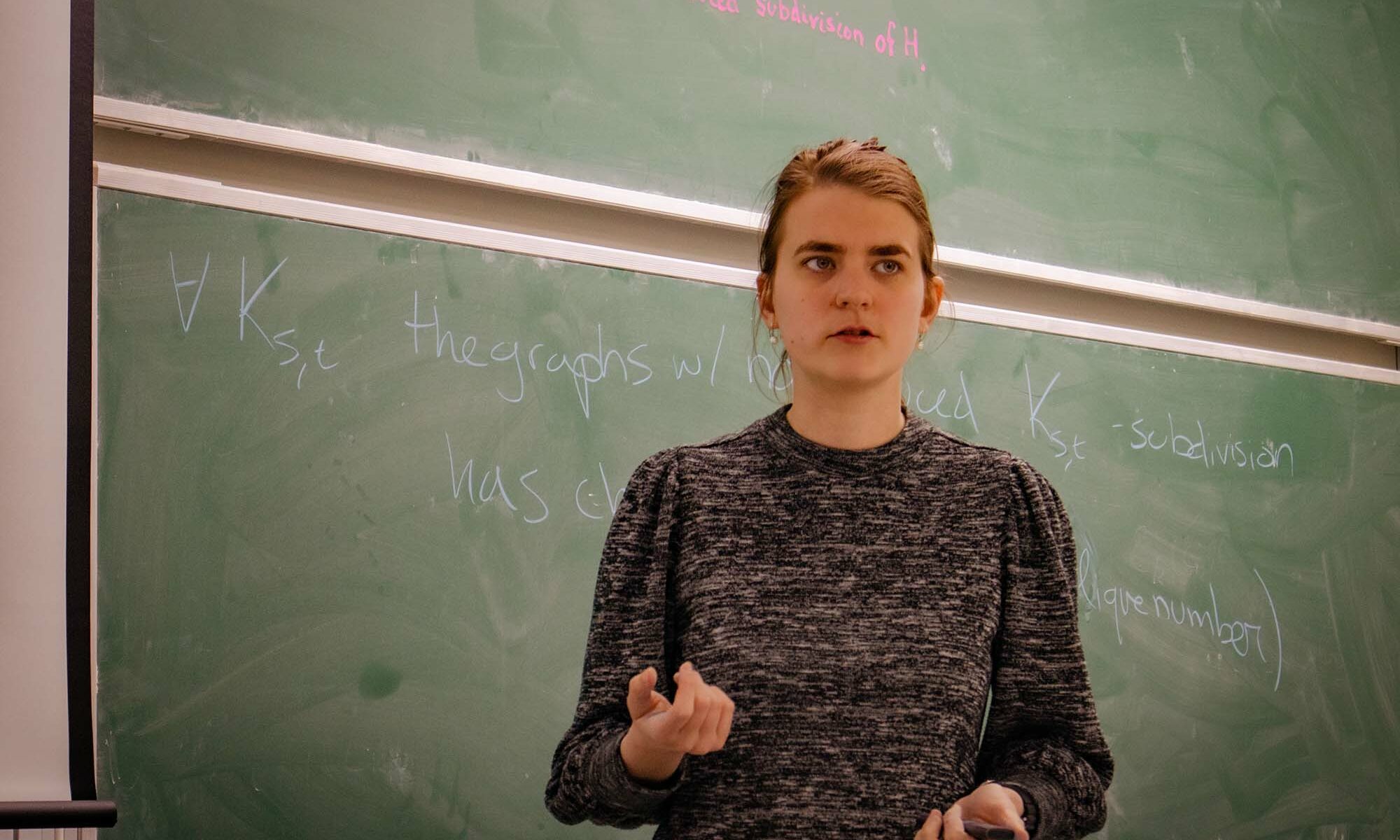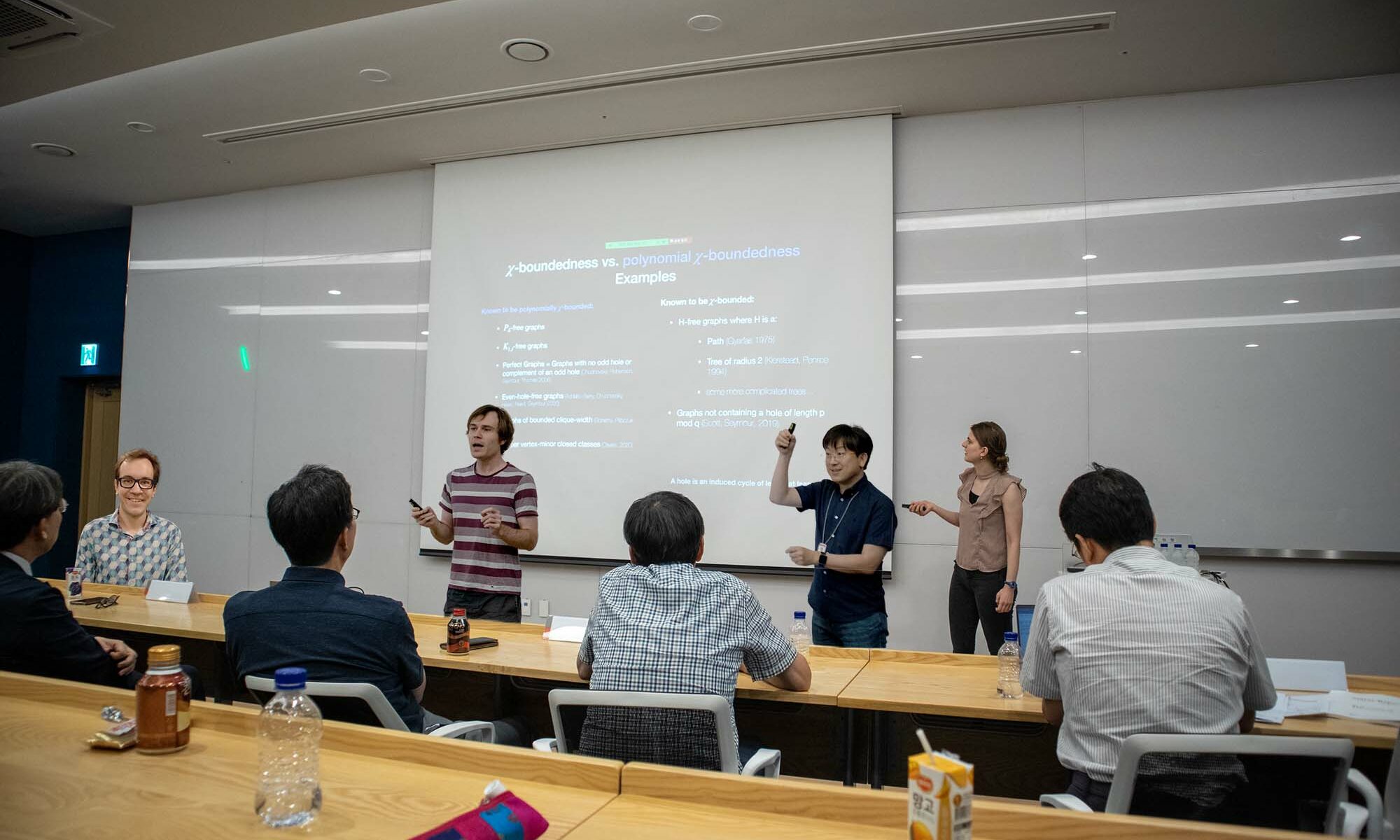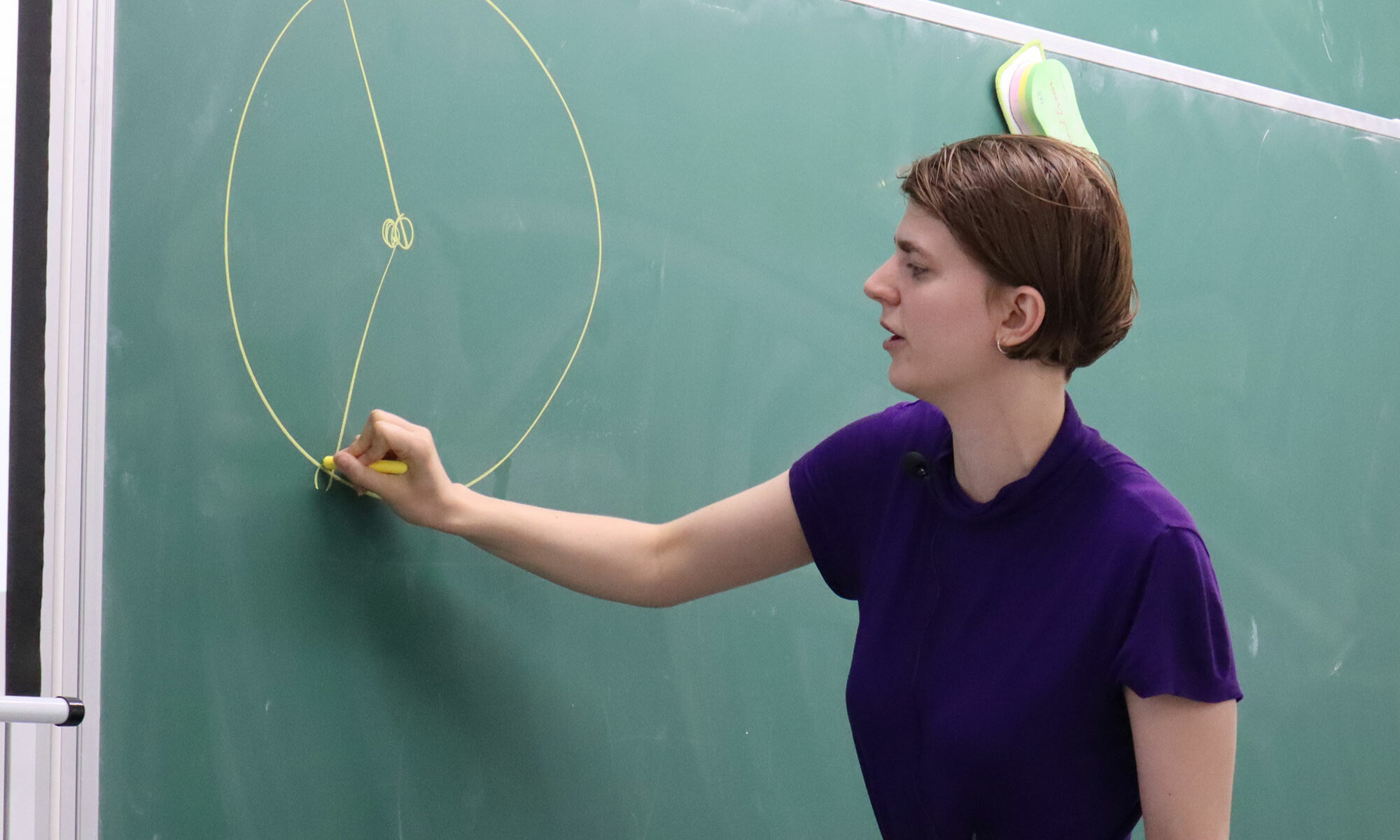On March 12, 2024, Linda Cook from the IBS Discrete Mathematics Group gave a talk at the Discrete Math Seminar about bounding the average degree of a graph with no subgraph isomorphic to a fixed complete bipartite graph or a subdivision of a fixed graph by a polynomial function of the size of the complete bipartite graph. The title of her talk was “On polynomial degree-boundedness“.
Linda Cook, On polynomial degree-boundedness
We prove a conjecture of Bonamy, Bousquet, Pilipczuk, Rzążewski, Thomassé, and Walczak, that for every graph $H$, there is a polynomial $p$ such that for every positive integer $s$, every graph of average degree at least $p(s)$ contains either $K_{s,s}$ as a subgraph or contains an induced subdivision of $H$. This improves upon a result of Kühn and Osthus from 2004 who proved it for graphs whose average degree is at least triply exponential in $s$ and a recent result of Du, Girão, Hunter, McCarty and Scott for graphs with average degree at least singly exponential in $s$.
As an application, we prove that the class of graphs that do not contain an induced subdivision of $K_{s,t}$ is polynomially $\chi$-bounded. In the case of $K_{2,3}$, this is the class of theta-free graphs, and answers a question of Davies. Along the way, we also answer a recent question of McCarty, by showing that if $\mathcal{G}$ is a hereditary class of graphs for which there is a polynomial $p$ such that every bipartite $K_{s,s}$-free graph in $\mathcal{G}$ has average degree at most $p(s)$, then more generally, there is a polynomial $p’$ such that every $K_{s,s}$-free graph in $\mathcal{G}$ has average degree at most $p'(s)$. Our main new tool is an induced variant of the Kővári-Sós-Turán theorem, which we find to be of independent interest.
This is joint work with Romain Bourneuf (ENS de Lyon), Matija Bucić (Princeton), and James Davies (Cambridge),
Linda Cook was interviewed on a video posted by the Ministry of Science and ICT
Linda Cook of the IBS Discrete Mathematics Group was interviewed on a video posted by the Ministry of Science and ICT, featuring international researchers in Korea.
Linda Cook gave a talk on bounding the dichromatic number after forbidding a fixed orientation of a path at the Discrete Math Seminar
On August 22, 2023, Linda Cook from the IBS Discrete Mathematics Group gave a talk at the Discrete Math Seminar on bounding the dichromatic number of a directed graph not having an induced subgraph isomorphic to a fixed orientation of a path. The title of her talk was “Orientations of P_4 bind the dichromatic number“.
Open Symposium at the Discrete Mathematics Group
On July 13, 2023, the Open Symposium at the Discrete Mathematics Group was held. There were four talks by the members of the Discrete Mathematics Group.
| 9:40-10:05 | Obstructions for dense analogs of tree-depth | Sang-il OUM |
| 10:05-10:20 | Structural and extremal results for twin-width | Kevin HENDREY |
| 10:20-10:35 | Down-sets in combinatorial posets | Rutger CAMPBELL |
| 10:35-10:50 | Reuniting 𝜒-boundedness with polynomial 𝜒-boundedness | Linda COOK |
Linda Cook, Orientations of $P_4$ bind the dichromatic number
An oriented graph is a digraph that does not contain a directed cycle of length two. An (oriented) graph $D$ is $H$-free if $D$ does not contain $H$ as an induced sub(di)graph.
The Gyárfás-Sumner conjecture is a widely-open conjecture on simple graphs, which states that for any forest $F$, there is some function $f$ such that every $F$-free graph $G$ with clique number $\omega(G)$ has chromatic number at most $f(\omega(G))$.
Aboulker, Charbit, and Naserasr [Extension of Gyárfás-Sumner Conjecture to Digraphs; E-JC 2021] proposed an analogue of this conjecture to the dichromatic number of oriented graphs. The dichromatic number of a digraph $D$ is the minimum number of colors required to color the vertex set of $D$ so that no directed cycle in $D$ is monochromatic. Aboulker, Charbit, and Naserasr’s $\overrightarrow{\chi}$-boundedness conjecture states that for every oriented forest $F$, there is some function $f$ such that every $F$-free oriented graph $D$ has dichromatic number at most $f(\omega(D))$, where $\omega(D)$ is the size of a maximum clique in the graph underlying $D$.
In this talk, we perform the first step towards proving Aboulker, Charbit, and Naserasr’s $\overrightarrow{\chi}$-boundedness conjecture by showing that it holds when $F$ is any orientation of a path on four vertices.
Linda Cook gave a talk on (1) the recognition algorithm for graphs with no long even holes and (2) the structure of graphs with no holes of length≠𝓁 at the Discrete Math Seminar
On August 17, 2021, Linda Cook from the IBS Discrete Mathematics Group gave a talk at the Discrete Math Seminar on (1) a polynomial-time algorithm to detect long even holes and (2) a structure of graphs with no holes of length≠𝓁 for a fixed 𝓁≥7. The title of her talk was “Two results on graphs with holes of restricted lengths“.
Linda Cook, Two results on graphs with holes of restricted lengths
We call an induced cycle of length at least four a hole. The parity of a hole is the parity of its length. Forbidding holes of certain types in a graph has deep structural implications. In 2006, Chudnovksy, Seymour, Robertson, and Thomas famously proved that a graph is perfect if and only if it does not contain an odd hole or a complement of an odd hole. In 2002, Conforti, Cornuéjols, Kapoor, and Vuškovíc provided a structural description of the class of even-hole-free graphs. I will describe the structure of all graphs that contain only holes of length $\ell$ for every $\ell \geq 7$ (joint work with Jake Horsfield, Myriam Preissmann, Paul Seymour, Ni Luh Dewi Sintiari, Cléophée Robin, Nicolas Trotignon, and Kristina Vuškovíc.
Analysis of how holes interact with graph structure has yielded detection algorithms for holes of various lengths and parities. In 1991, Bienstock showed it is NP-Hard to test whether a graph G has an even (or odd) hole containing a specified vertex $v \in V(G)$. In 2002, Conforti, Cornuéjols, Kapoor, and Vuškovíc gave a polynomial-time algorithm to recognize even-hole-free graphs using their structure theorem. In 2003, Chudnovsky, Kawarabayashi, and Seymour provided a simpler and slightly faster algorithm to test whether a graph contains an even hole. In 2019, Chudnovsky, Scott, Seymour, and Spirkl provided a polynomial-time algorithm to test whether a graph contains an odd hole. Later that year, Chudnovsky, Scott, and Seymour strengthened this result by providing a polynomial-time algorithm to test whether a graph contains an odd hole of length at least $\ell$ for any fixed integer $\ell \geq 5$. I will present a polynomial-time algorithm (joint work with Paul Seymour) to test whether a graph contains an even hole of length at least $\ell$ for any fixed integer $\ell \geq 4$.
Welcome Linda Cook, a new member of IBS Discrete Mathematics Group
The IBS discrete mathematics group welcomes Dr. Linda Cook, a new research fellow at the IBS discrete mathematics group from August 1, 2021. She received her Ph.D. from the Program in Applied and Computational Mathematics at Princeton University under the supervision of Prof. Paul Seymour. She is interested in structural graph theory and its algorithmic applications.







